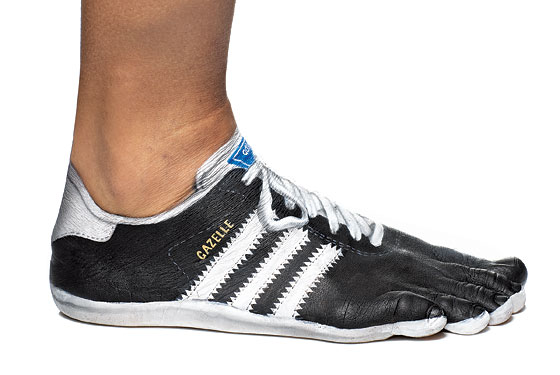...just a little story about what my wandering eyes did spy.

A young college student of my acquaintance arrived wearing this exceptional footwear and I simply had to take a picture. My plan was only to compare these "toe-shoes" to the only other gear I know that goes by the same name.

Not so fast....
You Walk Wrong
or so it said in the multi-part article I read on-line in New York Magazine. I read this story as research about shoes with toes and suddenly the blog entry became more complex. Here was all sorts of information that fascinated me. While blog readers would not need to know all of it, a distillation of the relevant bits seemed in order.
Makeup by John Mauraud and Jenai Chin
Dr. William A. Rossi writing in Podiatry Management makes the statement that it took 4 million years of evolution to develop the human foot and our distinctive gait pattern. The typical human foot is an anatomical marvel of evolution with 26 bones, 33 muscles and hundreds of sensory receptors, tendons and ligaments. A multitude of studies demonstrate that the majority of modern footwear creates an unhealthy gait dynamic.
They aren't talking spike heels here.

Two studies I found particularly intriguing focused on expensive running shoes. One published in Medicine and Science in Sports and Exercise demonstrated that wearers of the expensive running shoes were injured more frequently than runners wearing the less expensive shoes (those under $40). In the second study, people running in hard soled shoes sustained injuries at a rate of 14.3 per 1,000 kilometers run. This compares to a more than doubled injury rate of 31.9 per 1,000 kilometers for the runners outfitted in expensive cushioned running shoes.
The cushioning may be part of the problem. Researchers at McGill University in Montreal determined that the more padding there was built into a running shoe, the more force the runner exerted hitting the ground. The foot apparently needs to sense the ground in order to balance our bodies. So runners override the padding built into shoes and along with greater force impacting the foot, there is also an associated increase in forces transmitted to the knee and hip.

Studies point to the fact that our feet were designed for barefoot walking. Barefoot is best. Comparisons of the feet of populations that frequently walk barefoot, in this case the Zulu, with those of habitual shoe wearers like the Europeans, found that healthier feet were positively correlated with less shoe wear.

As barefoot is not feasible in most urban environments, we see the development of Vibram's FiveFingers. As their website touts:
FiveFingers enhance your sense of touch and feel, while improving foot strength, balance, agility, and range of motion. Because wearing Vibram FiveFingers is so close to going barefoot, you’ll enjoy the health and performance benefits of barefooting without some of the risks.
I don't know that I will be running out to get a pair, but I do believe I'll be letting my dogs out a little more often.
Carina






This post is so informative, I learn more things about shoes and by comparing shoes from other shoes. Thanks for sharing such a good ideas.
ReplyDeletezbsports